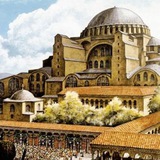Today we venerate Saint George, one of Christianity's most revered martyrs, which is an excellent opportunity to take a look at the church-mosque dedicated to him in Lod, Israel.
Nowadays the complex, which has survived much, consists of an Orthodox church rebuilt from the remains of a Crusader cathedral, a mosque rebuilt from the cathedral's Byzantine chapel, and a courtyard that combines them, formerly the cathedral's nave.
Nowadays the complex, which has survived much, consists of an Orthodox church rebuilt from the remains of a Crusader cathedral, a mosque rebuilt from the cathedral's Byzantine chapel, and a courtyard that combines them, formerly the cathedral's nave.
The Church of the Merciful Saviour in Belozersk might at first sight seem to be a standard example of the XVII century Russian traditions, but the unusual shapes, the style of the tiles, the apse roof, the large windows - hint that it was built at the beginning of the XVIII century under the influence of Baroque.
The Art Nouveau City Trade House of Russian Novo-Nikolayevsk (modern Novosibirsk) which was built for the rapidly developing city in 1911.
The first floor housed shops, the second floor the state bank, the city administration, treasury and hall, while the basement housed a boiler house and a power station.
The first floor housed shops, the second floor the state bank, the city administration, treasury and hall, while the basement housed a boiler house and a power station.
It seems to be a former Uniate or even Catholic church somewhere in Belorussia or Poland, but in fact it is a modern church in Blagoveshchensk, in the Far East, far from the western borders of Russia.
What do you think of this unconventional design?
What do you think of this unconventional design?
Saint Nicholas Cathedral with its unusual vault, built on the site of the meeting of the Apostles Peter and Paul in Sidon, Lebanon.
This appearance of the church arose in part because the original structure was divided by a wall into two parts - an Orthodox and a Greek-Catholic. Since then, the Catholic part of the building has apparently disappeared, while the Orthodox has remained.
This appearance of the church arose in part because the original structure was divided by a wall into two parts - an Orthodox and a Greek-Catholic. Since then, the Catholic part of the building has apparently disappeared, while the Orthodox has remained.
